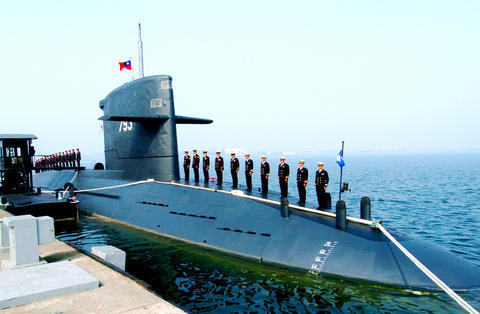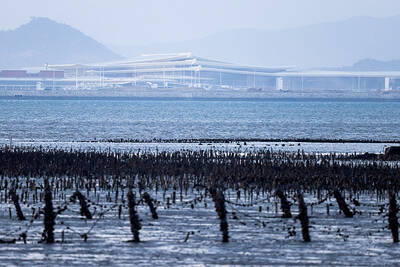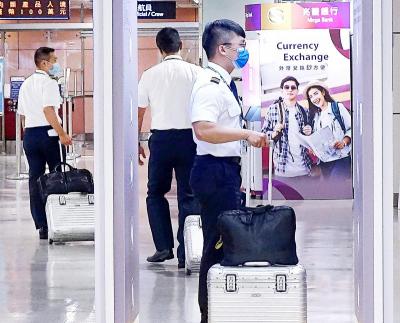New ships don't come easily for the nation's Navy. While commanding officers were celebrating the 20 years of service for the nation's two Dutch-made Zwaardvis-class diesel-electric submarines earlier this month, they must have been hoping for speedy legislative approval of a budget proposal for eight new US diesel-electric submarines.
The budget remains blocked in the legislature by the Chinese Nationalist Party (KMT). KMT Legislator Su Chi (
While attending the celebrations on Dec. 18 marking the 20th anniversary of the SS-793 Sea Dragon and SS-794 Sea Tiger at Mercury Port at the nation's largest naval base in Tsoying, Kaohsiung, President Chen Shui-bian (

PHOTO: CHANG CHUNG-YI, TAIPEI TIMES
Mercury Port houses the Navy's full complement of four submarines, which include two US-made Guppy-class (World War II era) vessels -- the SS-791 Sea Lion and SS-792 Sea Leopard -- as well as the two Dutch-made vessels.
The Navy's submarine fleet commander Rear Admiral Huang Shu-kuang (
"I would venture that we still have quality submariners despite the age of our vessels. I am also confident that our remaining submarines are all in very good shape and capable of accomplishing all our necessary missions," Huang said.
Just last month, the Sea Tiger and its crew completed a challenging long-term mission. But because of the sensitive nature of the exercise, the Navy could not provide any details.
Naval Commander-in-Chief Admiral Wang Li-shen (
TOUGH JOB
Retired Rear Admiral Ding Chien-ching (
The first group of sailors that was assigned to the two Dutch-made submarines had it even tougher as they participated in the entire building process of the two vessels.
"I am quite proud to say that we know every single nut and bolt on those vessels," Ding said.
The retired captain said he and his fellow sailors arrived in Holland in 1983, when construction was just beginning on the two submarines. Every one of them participated in the process and they also did the final tests on their own when the two vessels were completed.
"Our only hope was to finish the job as soon as possible so the two submarines could begin service as soon as possible," Ding said.
In the Navy, submariners are regarded as hard-working and low-profile navy boys, he said.
"That is because most of the time on board a submarine, we have to get a lot of things done instead of wasting our time complaining," Ding said. "That is what we were trained for and also the spirit of submarine personnel -- just shut up and do it."
Ding's remarks were echoed by Captain Chan Ying-chi (
"People ask me what it takes to become a submarine captain. I tell them the spirit of `follow me' is the key in leading the crew," Chan said.
As a leader, Chang said he always tries to encourage his fellow seamen by doing it first and doing it himself.
"Gradually, you become a role model and the rest of the sailors will follow you," Chan said. "Do not complain. Just do it."
The Zwaardvis Class (Swordfish) is a conventional attack submarine that replaced the Dolfijn Class in the Royal Netherlands Navy. It is based on the US Barbel Class with a teardrop hull design. Taiwan ordered two modified Zwaardvis Class submarines in September of 1981.
A repeat order for four additional vessels was turned down by the Netherlands in 1992 following pressure from China.
The Zwaardvis, which is 66.9m long, weighs 2,376 tonnes on the surface and 2,660 tonnes when submerged. It has six torpedo tubes. Top speed is about 20 knots (37kph). It carries 67 sailors, including eight officers and can dive to 240m.

Three Taiwanese airlines have prohibited passengers from packing Bluetooth earbuds and their charger cases in checked luggage. EVA Air and Uni Air said that Bluetooth earbuds and charger cases are categorized as portable electronic devices, which should be switched off if they are placed in checked luggage based on international aviation safety regulations. They must not be in standby or sleep mode. However, as charging would continue when earbuds are placed in the charger cases, which would contravene international aviation regulations, their cases must be carried as hand luggage, they said. Tigerair Taiwan said that earbud charger cases are equipped

Foreign travelers entering Taiwan on a short layover via Taiwan Taoyuan International Airport are receiving NT$600 gift vouchers from yesterday, the Tourism Administration said, adding that it hopes the incentive would boost tourism consumption at the airport. The program, which allows travelers holding non-Taiwan passports who enter the country during a layover of up to 24 hours to claim a voucher, aims to promote attractions at the airport, the agency said in a statement on Friday. To participate, travelers must sign up on the campaign Web site, the agency said. They can then present their passport and boarding pass for their connecting international

UNILATERAL MOVES: Officials have raised concerns that Beijing could try to exert economic control over Kinmen in a key development plan next year The Civil Aviation Administration (CAA) yesterday said that China has so far failed to provide any information about a new airport expected to open next year that is less than 10km from a Taiwanese airport, raising flight safety concerns. Xiamen Xiangan International Airport is only about 3km at its closest point from the islands in Kinmen County — the scene of on-off fighting during the Cold War — and construction work can be seen and heard clearly from the Taiwan side. In a written statement sent to Reuters, the CAA said that airports close to each other need detailed advanced

The age requirement for commercial pilots and airline transport pilots is to be lowered by two years, to 18 and 21 years respectively, to expand the pool of pilots in accordance with international standards, the Ministry of Transportation and Communications announced today. The changes are part of amendments to articles 93, 119 and 121 of the Regulations Governing Licenses and Ratings for Airmen (航空人員檢定給證管理規則). The amendments take into account age requirements for aviation personnel certification in the Convention on International Civil Aviation and EU’s aviation safety regulations, as well as the practical needs of managing aviation personnel licensing, the ministry said. The ministry